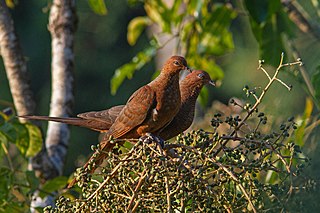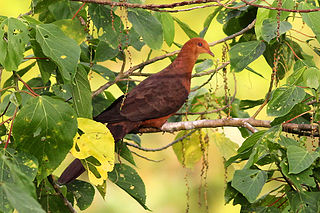
The Amboyna cuckoo-dove is a dove in the genus Macropygia found in the Moluccas and New Guinea. It was one of three new species defined when the slender-billed cuckoo-dove was split up in 2016 and retains the Latin binomial of the former species.[1]

The ruddy cuckoo-dove is a species of bird in the family Columbidae. It is a medium-sized, reddish brown cuckoo-dove, found in Brunei, Indonesia, and Malaysia. It is rated as a species of least concern on the International Union for Conservation of Nature Red List of Endangered Species.

Macropygia is a genus of bird in the pigeon and dove family Columbidae. The genus is one of three genera known as cuckoo-doves. They are long tailed, range between 27 and 45 cm in length and have brown plumage. The genus ranges from India and China through Indonesia and the Philippines to Vanuatu and Australia.

Mackinlay's cuckoo-dove, also known as the spot-breasted cuckoo-dove, is a species of bird in the family Columbidae. It is found in Papua New Guinea, Solomon Islands, and Vanuatu. It is rated as a species of least concern on the International Union for Conservation of Nature Red List of Endangered Species.
The Timor cuckoo-dove is a species of bird in the family Columbidae. It is found in Timor, Wetar and the eastern Lesser Sundas. It was previously lumped together with the Tanimbar cuckoo-dove and the Flores Sea cuckoo-dove as the dusky or bar-necked cuckoo-dove. It is rated as a species of least concern on the International Union for Conservation of Nature Red List of Endangered Species.
The bar-tailed cuckoo-dove is a species of bird in the family Columbidae. It is native to New Guinea and the Bismarck Archipelago. It is rated as a species of least concern on the International Union for Conservation of Nature Red List of Endangered Species.

The little cuckoo-dove is a species of bird in the family Columbidae. It is a reddish brown pigeon, and is found in Brunei, China, Indonesia, Laos, Malaysia, Myanmar, Thailand, and Vietnam. It is rated as a species of least concern on the International Union for Conservation of Nature Red List of Endangered Species.

The Andaman cuckoo-dove is a species of bird in the family Columbidae.

The Philippine cuckoo-dove is a species of bird in the family Columbidae. It is found in the Philippines and Taiwan and is rated as a species of least concern on the International Union for Conservation of Nature Red List of Endangered Species.

The barred cuckoo-dove is a bird species in the family Columbidae. It is native to South and Southeast Asia, and listed as Least Concern on the IUCN Red List.

The red-moustached fruit dove is an extinct species of bird in the family Columbidae. It was endemic to French Polynesia. The last record was of the subspecies P. m. tristrami on Hiva Oa, in 1922. Its extinction has been attributed to predation by the introduced great horned owl, as well as by introduced rats and cats. In 1994, it was listed as an extinct species on the International Union for Conservation of Nature Red List of Endangered Species.
The Huahine cuckoo-dove is an extinct species of bird in the family Columbidae. It was endemic to French Polynesia where subfossil bones between 750 and 1250 years old have been found at the Fa'ahia early occupation site on Huahine in the Society Islands.
The great ground dove is an extinct species of bird in the family Columbidae. It was found in Mangaia in the southern Cook Islands, and in French Polynesia where subfossil bones between 1000 and 2000 years old have been found in the Marquesas, as well as between 750 and 1250 years old at the Fa'ahia early occupation site on Huahine in the Society Islands.
The Tahuata rail is an extinct species of flightless bird in the Rallidae, or rail family.

The brown cuckoo-dove is a dove in the genus Macropygia found in Australia from Weipa and Aurukun in the north to Bega in the south, and most inland at Atherton and Toowoomba. It is sometimes called the "brown pigeon" or "pheasant pigeon", but both terms are best avoided, as they can lead to confusion with the brown doves and the true pheasant pigeon. It was one of three new species defined when the slender-billed cuckoo-dove was split in 2016.
The Tanimbar cuckoo-dove is a species of bird in the family Columbidae. It is endemic to the Tanimbar Islands in Indonesia. It was previously grouped together with the Timor cuckoo-dove and the Flores Sea cuckoo-dove as the dusky or bar-necked cuckoo-dove.
The Flores Sea cuckoo-dove is a species of bird in the family Columbidae. It is found on Sulawesi, Tanakeke and Selayar Islands, and some of the eastern Lesser Sundas. It was previously lumped together with the Tanimbar cuckoo-dove and the Timor cuckoo-dove as the dusky or bar-necked cuckoo-dove. The Flores Sea cuckoo-dove has two subspecies:
The Enggano cuckoo-dove is a species of bird in the family Columbidae. It is endemic to Enggano Island in Indonesia. Until 2016, it was considered a subspecies of the ruddy cuckoo-dove.
The slender-billed cuckoo-dove was until recently the name of a species of bird in the family Columbidae. Its range covered Brunei, Indonesia, Malaysia, Papua New Guinea and northern Australia. The binomial M. amboinensis now refers to the Amboyna cuckoo-dove. The taxonomy of the slender-billed cuckoo-dove was complex, but most authorities now split it into four species based on analyses of vocalizations. This will be further refined by future genetic analyses.









